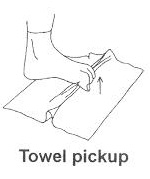Plantar Fasciitis Rehabilitation Exercises
You may begin exercising the muscles of your foot right away by gently stretching them as follows:
 1. Towel Stretch
1. Towel Stretch
Sit on a hard surface with your injured leg stretched out in front of you. Loop a towel around the ball of your foot and pull the towel toward your body, stretching the back of your calf muscle. Hold this position for 30 seconds. Repeat 3 times. When the towel stretch becomes too easy, you may begin doing the standing calf stretch.
2. Standing Calf Stretch
 Facing a wall, put your hands against the wall at about eye level. Keep the injured leg back, the uninjured leg forward, and the heel of your injured leg on the floor. Turn your injured foot slightly inward (as if you were pigeon-toed) as you slowly lean into the wall until you feel a stretch in the back of your calf. Hold for 30 to 60 seconds. Repeat 3 times. When you can stand comfortably on your injured foot, you can begin stretching the planter fascia at the bottom of your foot.
Facing a wall, put your hands against the wall at about eye level. Keep the injured leg back, the uninjured leg forward, and the heel of your injured leg on the floor. Turn your injured foot slightly inward (as if you were pigeon-toed) as you slowly lean into the wall until you feel a stretch in the back of your calf. Hold for 30 to 60 seconds. Repeat 3 times. When you can stand comfortably on your injured foot, you can begin stretching the planter fascia at the bottom of your foot.
 3. Standing Soleus Stretch
3. Standing Soleus Stretch
Stand with the ball of your injured foot on a stair. Reach for the bottom step with your heel until you feel a stretch in the arch of your foot. Hold this position for 30 to 60 seconds and then relax Repeat 3 times.
After you have stretched the bottom muscles of your foot, you can begin strengthening the top muscles of your foot.
 4. Frozen Can Roll
4. Frozen Can Roll
Roll your bare injured foot back and forth from your heel to your mid-arch over a frozen juice can. Repeat for 3 to 5 minutes. This exercise is particularly helpful if done first thing in the morning.
 5. Sitting toe Raise
5. Sitting toe Raise
Sit in a chair with your feet flat on the floor. Raise the toes and the ball of your injured foot off the floor while keeping your heel on the floor. Hold for 5 seconds. Repeat 10 times. Do three sets of 10.
 6. Towel Pickup
6. Towel Pickup
With your heel on the ground, pick up a towel with your toes. Release. Repeat 10 to 20 times. Next, you can begin strengthening the muscles of your foot and lower leg by using a Thera-Band.
7. Resisted Thera-Band exercises for the lower leg
 A. Resisted dorsiflexion
A. Resisted dorsiflexion
Sit with your injured leg out straight and your foot facing a doorway. Tie a loop in one end of the Thera-Band. Put your foot through the loop so that the tubing goes around the arch of your foot. lie a knot in the other end of the Thera-Band and shut the knot in the door. Move backward until there is tension in the tubing. Keeping your knee straight, pull your foot toward your face, stretching the tubing. Slowly return to the starting position.
Repeat 10 times. Do 3 sets of 10.
B. Resisted plantar flexion
Sit with your leg outstretched and loop the middle section of the tubing around the ball of your foot. Hold the ends of the tubing in both hands. Gently press the ball of your foot down and point your toes, stretching the Thera-Band. Return to the starting position. Repeat 10 times. Do 3 sets of 10.
 C. Resisted inversion
C. Resisted inversion
Sit with your legs out straight and cross your un- injured leg over your injured ankle. Wrap the tubing around the ball of your injured foot and then loop it around your uninjured foot so that the Thera-Band is anchored there at one end. Hold the other end of the Thera-Band in your hand. Turn your injured foot inward and upward. This will stretch the tubing. Return to the starting position. Repeat 10 times. Do 3 sets of 10.
D. Resisted eversion
Sit with both legs stretched out in front of you, with your feet about a shoulder's width apart. Tie a loop in one end of the Thera-Band. Put your injured foot through the loop so that the tubing goes around the arch of that foot and wraps around the outside of the uninjured foot. Hold onto the other end of the tubing with your hand to provide tension. Turn your injured foot up and out. Make sure you keep your uninjured foot still so that it will allow the tubing to stretch as you move your injured foot. Return to the starting position. Repeat 10 times. Do 3 sets of 10.